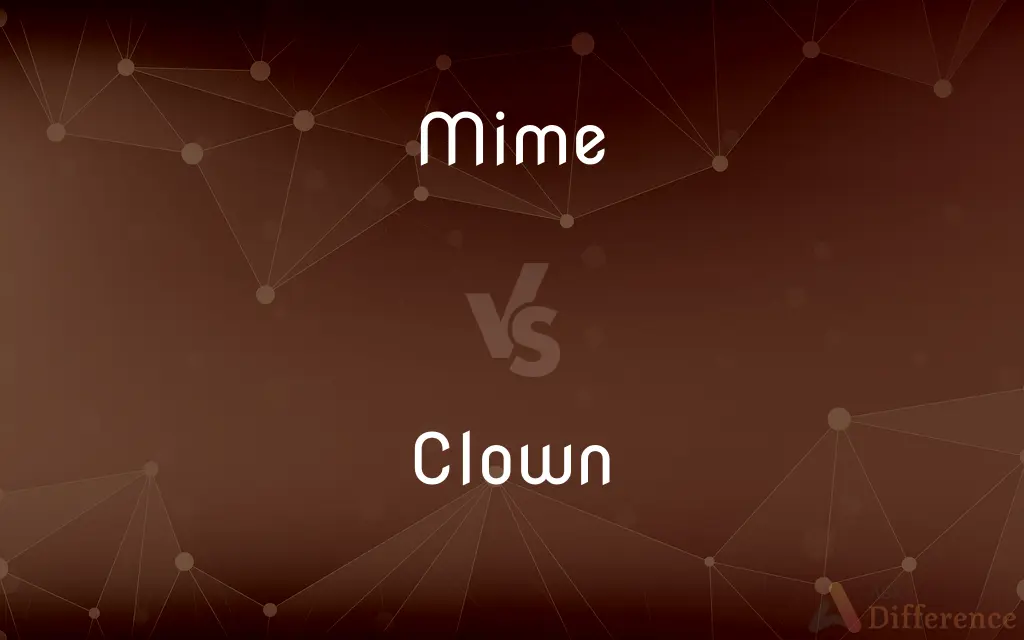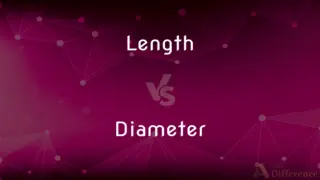Mime vs. Clown — What's the Difference?
By Tayyaba Rehman — Updated on October 9, 2023
A mime expresses stories through silent gestures, while a clown uses exaggerated makeup and comedy to entertain.

Difference Between Mime and Clown
Table of Contents
ADVERTISEMENT
Key Differences
A mime is an artist who specializes in pantomime, which means conveying a story or message through silent movement and facial expressions. This performance art emphasizes non-verbal storytelling, often using exaggerated gestures. In contrast, a clown is a performer who typically uses humor, slapstick, and often verbal interactions to entertain. They wear bright and exaggerated makeup and costumes.
While mimes often stick to neutral colors and may paint their face entirely white, emphasizing the non-verbal communication, clowns use colorful makeup and exaggerated facial features, often including a red nose, to convey their comical persona.
The intent of a mime is usually to create a visual story without words, relying heavily on body language. Clowns, on the other hand, can use a variety of comedic tools, including verbal jokes, physical comedy, and props.
Both mimes and clowns have historical roots in entertainment. While the mime tradition can be traced back to ancient Greece and Roman theater, the clown figure is often associated with circus performances, though they have also been central in various cultures and theater forms.
Comparison Chart
Main Focus
Silent gestures and expressions
Humor, slapstick, and sometimes verbal interactions
ADVERTISEMENT
Appearance
Neutral colors, often white-painted face
Colorful makeup, exaggerated facial features, red nose
Communication
Non-verbal
Both verbal and non-verbal
Typical Setting
Street performances, theaters
Circuses, parties, theaters
Historical Roots
Ancient Greece and Roman theater
Various cultures, often associated with circus performances
Compare with Definitions
Mime
A silent performer using exaggerated expressions.
Children were fascinated by the mime at the park.
Clown
A person who acts in a silly or playful manner.
He was always the clown of the class, making everyone laugh.
Mime
A communications protocol that allows for the transmission of data in many forms, such as audio, binary, or video.
Clown
A figure associated with circuses and comedic acts.
She dressed up as a clown for Halloween.
Mime
A form of ancient Greek and Roman theatrical entertainment in which familiar characters and situations were farcically portrayed on stage, often with coarse dialogue and ludicrous actions.
Clown
A character using exaggeration for amusement.
The clown used slapstick comedy to get laughs.
Mime
A performance of or dialogue for such an entertainment.
Clown
A clown is a person who wears a unique makeup-face and flamboyant costume, performing comedy in a state of open-mindedness (by reversing folkway-norms) all while using physical comedy.
Mime
A performer in a mime.
Clown
A comic entertainer, especially one in a circus, wearing a traditional costume and exaggerated make-up
A circus clown
Mime
A modern performer who specializes in comic mimicry.
Clown
An unsophisticated country person; a rustic.
Mime
The art of portraying characters and acting out situations or a narrative by gestures and body movement without the use of words; pantomime.
Clown
Behave in a comical or playful way
Harvey clowned around pretending to be a dog
Mime
A performance of pantomime.
Clown
A buffoon or jester who entertains by jokes, antics, and tricks in a circus, play, or other presentation.
Mime
An actor or actress skilled in pantomime.
Clown
One who jokes and plays tricks.
Mime
To ridicule by imitation; mimic.
Clown
A coarse, rude, vulgar person; a boor.
Mime
To act out with gestures and body movement.
Clown
A peasant; a rustic.
Mime
To act as a mimic.
Clown
To behave like a buffoon or jester.
Mime
To portray characters and situations by gesture and body movement.
Clown
To perform as a buffoon or jester.
Mime
A form of acting without words; pantomime.
Clown
To krump, especially in clown makeup.
Mime
A pantomime actor.
Clown
A slapstick performance artist often associated with a circus and usually characterized by bright, oversized clothing, a red nose, face paint, and a brightly colored wig.
Mime
A classical theatrical entertainment in the form of farce.
Clown
A person who acts in a silly fashion.
He was regarded as the clown of the school, always playing pranks.
Mime
A performer of such a farce.
Clown
A stupid or badly-behaved person.
Mime
A person who mimics others in a comical manner.
Clown
(obsolete) A man of coarse nature and manners; an awkward fellow; an illbred person; a boor.
Mime
Any of various papilionid butterflies of the genus Chilasa or Papilio, that mimic other species in appearance.
Clown
(obsolete) One who works upon the soil; a rustic; a churl; a yokel.
Mime
A unit of imitation in the theory of symbiosism.
Clown
A clownfish.
Mime
To mimic.
Clown
To act in a silly or playful fashion.
Mime
(intransitive) To act without words.
Clown
To ridicule.
Mime
To represent an action or object through gesture, without the use of sound.
In this game, you're given a word, which you have to mime to the others in the group.
Clown
A man of coarse nature and manners; an awkward fellow; an ill-bred person; a boor.
Mime
A kind of drama in which real persons and events were generally represented in a ridiculous manner; an ancient Greek or Roman form of farce.
Clown
One who works upon the soil; a rustic; a churl.
The clown, the child of nature, without guile.
Mime
An actor in such representations.
Clown
The fool or buffoon in a play, circus, etc.
The clown shall make those laugh whose lungs are tickle o'the sere.
Mime
The art of representing actions, events, situations, or stories solely by gestures and body movements, without speaking; pantomime{3}.
Clown
To act as a clown; - with it.
Beshrew me, he clowns it properly indeed.
Mime
An actor who performs or specializes in mime{3}; an actor who communicates entirely by gesture and facial expression; a pantomime{2}; a pantomimist; a mimer.
Clown
A rude or vulgar fool
Mime
A mimic.
Clown
A person who amuses others by ridiculous behavior
Mime
To mimic.
Clown
Act as or like a clown
Mime
An actor who communicates entirely by gesture and facial expression
Clown
A comedic performer often in colorful makeup and costume.
The clown juggled balls at the circus.
Mime
A performance using gestures and body movements without words
Clown
An entertainer skilled in various forms of humor.
The birthday clown made balloon animals for the kids.
Mime
Imitate (a person, a manner, etc.), especially for satirical effect;
The actor mimicked the President very accurately
Mime
Act out without words but with gestures and bodily movements only;
The acting students mimed eating an apple
Mime
A performer expressing a story through silent gestures.
The mime captivated the audience with his silent story.
Mime
An art form based on pantomime and non-verbal storytelling.
She studied the art of mime in Paris.
Mime
A person who uses gestures without speech.
The mime conveyed emotion solely through movement.
Mime
A theatrical technique of suggesting action or emotion without words.
His skills as a mime were unparalleled.
Common Curiosities
Are clowns always associated with circuses?
While clowns are common in circuses, they also perform at parties, theaters, and other events.
Do mimes always wear white face paint?
Many mimes wear white face paint, but it's not a strict rule.
Is mime only a street performance art?
No, while many mimes perform on streets, they also appear in theaters and other venues.
Do clowns always use verbal jokes?
No, while many clowns use verbal humor, they also rely on physical comedy.
What is the purpose of a clown's colorful makeup?
A clown's makeup exaggerates facial features to emphasize emotions and enhance comedy.
Are clowns always meant to be funny?
While most clowns aim to amuse, some can take on more somber or artistic roles.
What is the primary mode of communication for a mime?
A mime primarily communicates through silent gestures.
How long has the art of mime been around?
The art of mime can be traced back to ancient Greece and Roman theater.
Is pantomime the same as mime?
While similar, pantomime often involves more exaggerated movements, while mime can be subtler.
Why might a mime use gloves in a performance?
Gloves can enhance the visibility of a mime's hand movements.
Can a performer be both a mime and a clown?
Yes, a performer can incorporate elements of both mime and clown in their act.
Do mimes always perform solo?
No, mimes can perform solo or as part of a group.
Why do clowns often wear oversized shoes?
Oversized shoes enhance the clown's comedic and exaggerated appearance.
Are there schools dedicated to clowning?
Yes, there are schools and workshops dedicated to teaching the art of being a clown.
Is mime popular globally?
Yes, mime is appreciated and practiced in many cultures worldwide.
Share Your Discovery

Previous Comparison
Length vs. Diameter
Next Comparison
Exploitive vs. ExploitativeAuthor Spotlight
Written by
Tayyaba RehmanTayyaba Rehman is a distinguished writer, currently serving as a primary contributor to askdifference.com. As a researcher in semantics and etymology, Tayyaba's passion for the complexity of languages and their distinctions has found a perfect home on the platform. Tayyaba delves into the intricacies of language, distinguishing between commonly confused words and phrases, thereby providing clarity for readers worldwide.













































